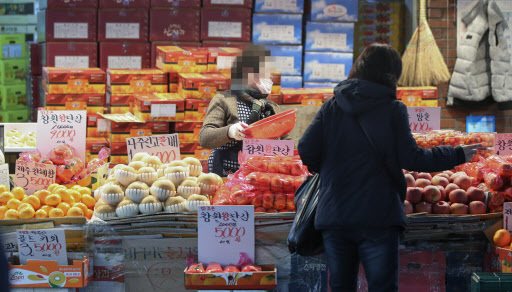What is cheapest option for Lunar New Year grocery shopping?
By Ock Hyun-juPublished : Jan. 28, 2021 - 16:13

Traditional markets are the cheapest option for grocery shopping for the upcoming Lunar New Year’s holiday, recent data showed, with food prices skyrocketing due to unusual weather patterns and the spread of bird flu.
An average four-member household in South Korea can expect to spend about 240,700 won ($215) on groceries for the “charye” table at a traditional market, up 16.4 percent from last year, according to data collected by Korea Price Information.
At a big supermarket, the same groceries would cost 344,200 won, up 18 percent from the previous year.
This year’s Lunar New Year holiday falls Feb. 11-14.
During the Lunar New Year’s holiday, Koreans perform an ancestral ritual called charye, during which families pay tribute to their ancestors with a table set with a wide variety of dishes made of vegetables, meat and fish, as well as fresh fruits.
Three apples cost about 12,000 to 18,000 won this year, up from 9,000 won to 9,980 won from a year earlier. Ten pieces of dried persimmon cost 10,000 to 12,480 won this year, compared with 8,000 won to 12,480 a year earlier.
One bunch of spring onions cost about 4,000 won to 4,980 won this year. It was 2,000 to 2,980 won last year.
For meat, 600 grams of high-quality beef for soup cost 33,000 won to 53,940 won this year, compared with 23,000 won to 38,400 won last year.
“The price dramatically increased in all categories, except for seafood, chips and alcohol,” the KPI said. “The price jump is especially noticeable in fruits, nuts, eggs, chicken and duck meat.”
The KPI attributed the price hike to weather abnormalities and bird flu.
Korea witnessed extreme weather events last year, such as an unusually long monsoon season that lasted six to seven weeks across the country, as well as more intense and frequent typhoons, which battered the country in autumn.
Recent reports of cases of highly pathogenic bird flu have also driven up consumer prices of eggs, chicken and duck meat. The country has culled 23 million birds so far in line with its policy of destroying all poultry within a 3-kilometer radius of infected farms.
By Ock Hyun-ju (laeticia.ock@heraldcorp.com)
An average four-member household in South Korea can expect to spend about 240,700 won ($215) on groceries for the “charye” table at a traditional market, up 16.4 percent from last year, according to data collected by Korea Price Information.
At a big supermarket, the same groceries would cost 344,200 won, up 18 percent from the previous year.
This year’s Lunar New Year holiday falls Feb. 11-14.
During the Lunar New Year’s holiday, Koreans perform an ancestral ritual called charye, during which families pay tribute to their ancestors with a table set with a wide variety of dishes made of vegetables, meat and fish, as well as fresh fruits.
Three apples cost about 12,000 to 18,000 won this year, up from 9,000 won to 9,980 won from a year earlier. Ten pieces of dried persimmon cost 10,000 to 12,480 won this year, compared with 8,000 won to 12,480 a year earlier.
One bunch of spring onions cost about 4,000 won to 4,980 won this year. It was 2,000 to 2,980 won last year.
For meat, 600 grams of high-quality beef for soup cost 33,000 won to 53,940 won this year, compared with 23,000 won to 38,400 won last year.
“The price dramatically increased in all categories, except for seafood, chips and alcohol,” the KPI said. “The price jump is especially noticeable in fruits, nuts, eggs, chicken and duck meat.”
The KPI attributed the price hike to weather abnormalities and bird flu.
Korea witnessed extreme weather events last year, such as an unusually long monsoon season that lasted six to seven weeks across the country, as well as more intense and frequent typhoons, which battered the country in autumn.
Recent reports of cases of highly pathogenic bird flu have also driven up consumer prices of eggs, chicken and duck meat. The country has culled 23 million birds so far in line with its policy of destroying all poultry within a 3-kilometer radius of infected farms.
By Ock Hyun-ju (laeticia.ock@heraldcorp.com)
-
Articles by Ock Hyun-ju






![[From the Scene] Monks, Buddhists hail return of remains of Buddhas](http://res.heraldm.com/phpwas/restmb_idxmake.php?idx=644&simg=/content/image/2024/04/19/20240419050617_0.jpg&u=20240419175937)








![[From the Scene] Monks, Buddhists hail return of remains of Buddhas](http://res.heraldm.com/phpwas/restmb_idxmake.php?idx=652&simg=/content/image/2024/04/19/20240419050617_0.jpg&u=20240419175937)

![[KH Explains] Hyundai's full hybrid edge to pay off amid slow transition to pure EVs](http://res.heraldm.com/phpwas/restmb_idxmake.php?idx=652&simg=/content/image/2024/04/18/20240418050645_0.jpg&u=20240419100350)

![[Today’s K-pop] Illit drops debut single remix](http://res.heraldm.com/phpwas/restmb_idxmake.php?idx=642&simg=/content/image/2024/04/19/20240419050612_0.jpg&u=)